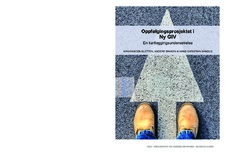| dc.contributor.author | Sletten, Mira Aaboen | |
| dc.contributor.author | Bakken, Anders | |
| dc.contributor.author | Sandlie, Hans Christian | |
| dc.date.accessioned | 2020-06-07T21:06:04Z | |
| dc.date.accessioned | 2021-04-29T14:03:02Z | |
| dc.date.available | 2020-06-07T21:06:04Z | |
| dc.date.available | 2021-04-29T14:03:02Z | |
| dc.date.issued | 2013 | |
| dc.identifier.isbn | 978-82-7894-484-4 | |
| dc.identifier.issn | 0808-5013 | |
| dc.identifier.uri | https://hdl.handle.net/20.500.12199/3420 | |
| dc.description.abstract | One of the major goals in Norwegian education policy is to improve the completion rate in upper secondary education. In 2011 the Government initiated a large-scale three-year effort – Ny GIV. The overarching goal is to increase the proportion of young people who successfully complete secondary education to 75 percent by 2015 (from 69 percent in 2010). The effort comprises three major sub-projects: 1) "Statistikkprosjektet", aiming at the development of a common database and statistical indicators to assess the extent to which the overarching objectives are obtained, 2) "Overgangsprosjektet", targeting young people at the end of lower secondary school who are at risk of not attending or completing upper secondary education and 3) "Oppfølgingsprosjektet" targeting young people aged 15-21 years who are neither in of education or employment. NOVA has been commissioned by the Ministry of Education and Research to evaluate the latter project, Oppfølgingsprosjektet, during the school years 2012/13 and 2013/14. The overall objective of the evaluation project is to examine the extent to which the project contributes to achieving the main goal in Ny GIV. The work in the counties will be assessed on the basis of the national and common priorities, which are: 1) Testing of training models that combine work experience with learning objectives in upper secondary school, 2) Strengthening of cooperation between the actors (the counties, NAV, schools etc) responsible for the follow-up of young people neither in employment or education, and 3) Skills training for employees working in the counties or the Norwegian welfare and labour service (NAV). This is the first report of the evaluation project and includes data from the school year 2012/13. The report gives an overview of new and previously implemented measures directed at the target group for Oppfølgingsprosjektet. The report also provides answers to how employees in the counties and NAV and school leaders experience both the effort of and the cooperation between relevant actors in the field. In addition, the report provides a picture of how young people are experiencing the measures they participate in and how a continuing education implemented within the framework of Oppfølgingsprosjektet work. The results from this report will later be updated for the school year 2013/14 and by the end of 2014, we will provide an overall assessment of how Oppfølgingsprosjektet has worked. The preliminary findings from this first part of the evaluation are as follows: - There is an extensive range of measures directed at youth who are neither in education or employment. In line with the overall goal of Oppfølgingsprosjektet, a large number of the initiated measures aim at raising young people's formal qualifications. About 30 percent of all measures combine educational learning objectives and work practices. It is still to early to conclude whether the extent of such combined measures has increased during the period of Oppfølgingsprosjektet. - By far, most of the measures are organized in collaboration between several actors. Actors involved in such cooperation usually are Oppfølgingstjenesten, administered by the counties, and NAV. The staffs of the two agencies are largely satisfied with how the partnership works - both in terms of planning actions and the guidance and supervision of youth. - So far, Oppfølgingsprosjektet has probably had its greatest impact at the cooperational level, affecting how and to which extent the major agencies involved in the different efforts to prevent young people dropping out of upper secondary school collaborate. This point is fairly unanimous in the assessment of employees in both the follow-up services, OT and NAV, and also appears in the evaluation of the training for employees working in the counties or NAV. | en |
| dc.description.abstract | I 2011 igangsatte Regjeringen Ny GIV, et treårig prosjekt for å øke gjennomføringen i videregående opplæring. Oppfølgingsprosjektet er ett av satsingsområdene, der målet er å styrke innsatsen overfor ungdom som er i ferd med å slutte, eller har sluttet, i videregående. Dette skal dels skje gjennom å prøve ut opplæringsmodeller som kombinerer arbeidspraksis med læreplanmål i videregående, dels gjennom et styrket samarbeid mellom de ulike aktørene som har ansvar for målgruppa. Det er også et mål å utvikle kompetansen til de ansatte. Denne underveisrapporten er basert på en kartlegging av igangsatte tiltak overfor målgruppa for Oppfølgingsprosjektet. Kartleggingen omfatter også hvordan skoleledere og ansatte i Oppfølgingstjenesten og NAV opplever samarbeidsrelasjonene og innsatsen som er rettet mot målgruppa. I tillegg gir rapporten et bilde av hvordan ungdom opplever tiltakene de deltar i, og hvordan videreutdanningstilbudet som er igangsatt innenfor rammene av Ny GIV, fungerer. | no_NB |
| dc.publisher | Oslo Metropolitan University - OsloMet: NOVA | |
| dc.relation.ispartofseries | NOVA Rapport 13/13 | |
| dc.subject | NOVA | |
| dc.title | Oppfølgingsprosjektet i Ny GIV | no_NB |
| dc.type | Report | |
| fagarkivet.author.link | https://www.oslomet.no/om/ansatt/masle | |
| fagarkivet.author.link | https://www.oslomet.no/om/ansatt/abakk | |
| fagarkivet.author.link | https://www.oslomet.no/om/ansatt/hcsan | |
| fagarkivet.source.pagenumber | 156 | |
